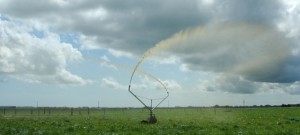The IRRIG8Quick Irrigation Calibration worksheets calculate a number called the Excess Water Fraction. A couple of recent queries have asked for more explanation, so here it is.
The Excess Water Factor uses Applied Depth and Distribution Uniformity (DU) to determine how much extra water is required to adequately water the area. This is compared to a perfect system (DU=1).
IRRIG8Quick uses DUlq, which is based on how much water the lowest quarter of the irrigated area receives compared to the average across the whole area. DUlq was (I think) introduced in the 1950s by the US Soil Conservation Service.
DUlq can be used to determine the Scheduling coefficient, or how much extra water should be applied to adequately irrigate most of the area. The Scheduling coefficient is just the reciprocal (1/DUlq). Alternatively, divide your target application depth by your system’s DUlq and apply that much irrigation.
Let’s say you aim to apply 20mm of irrigation. If your system has a DUlq of 0.80, then pump to apply 25mm (20 / 0.80 = 25). This way, 7/8th of the area will get at least the targeted 20mm. Some will get quite a bit more and some will get a wee bit less. But it is a good trade-off between getting enough watered and not wasting too much.
This explains why getting uniform application is so important. A system with a DUlq of 0.80 uses 25% extra water. A system with a DUlq of 0.50 would need 100% extra water.
That is what the Excess Water Fraction is working out.
The formula ((Depth ÷ DU) – Depth) ÷ Depth x 100 firstly calculates the total water that must be applied (depth / DU gives total depth needed). That minus depth gives the extra depth needed. That divided by the depth gives the percentage extra water needed.
An example.
- 20mm average depth
- DUlq 0.80
Solution
- 20 / 0.80 = 25 (average depth / DUlq)
- 25 – 20 = 5 (Total – average depth)
- 5 / 20 = 0.25 (Extra / average depth)
- 0.25 x 100 = 25% (convert to percentage)
You can use this to approximate how much extra money you spend on power and water (if you pay for it). It also shows how much water you could use elsewhere if the system was perfect.
You could also calculate the EWF for a very good system (say DU = 0.9 for a pivot), and compare how much extra water you are using compared to that ideal system.

